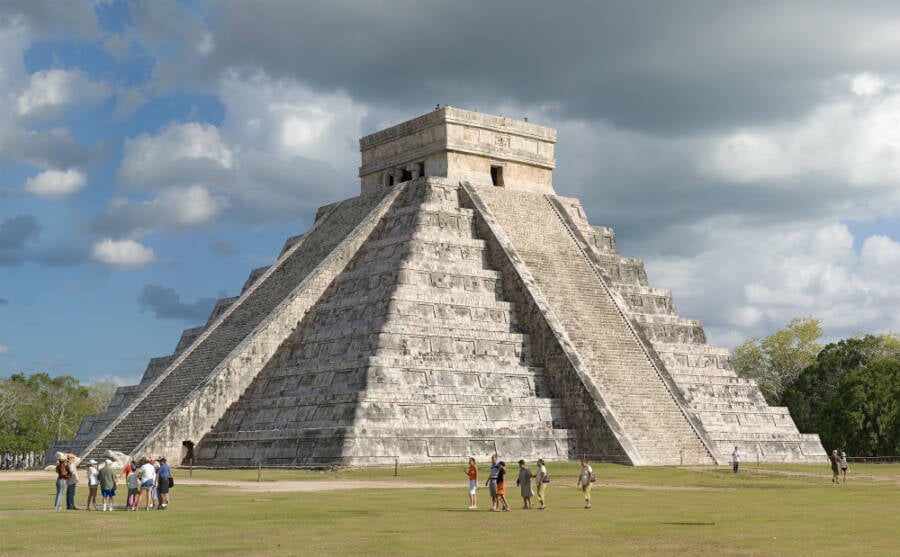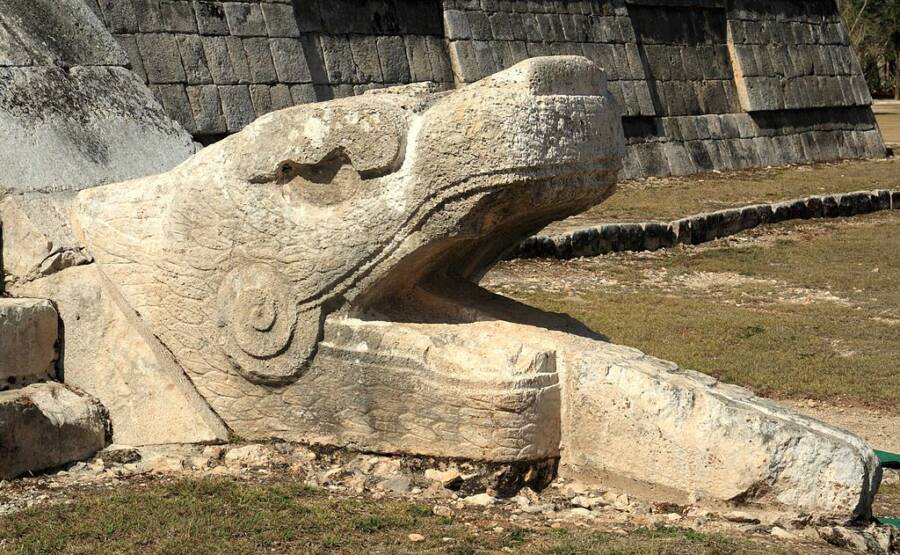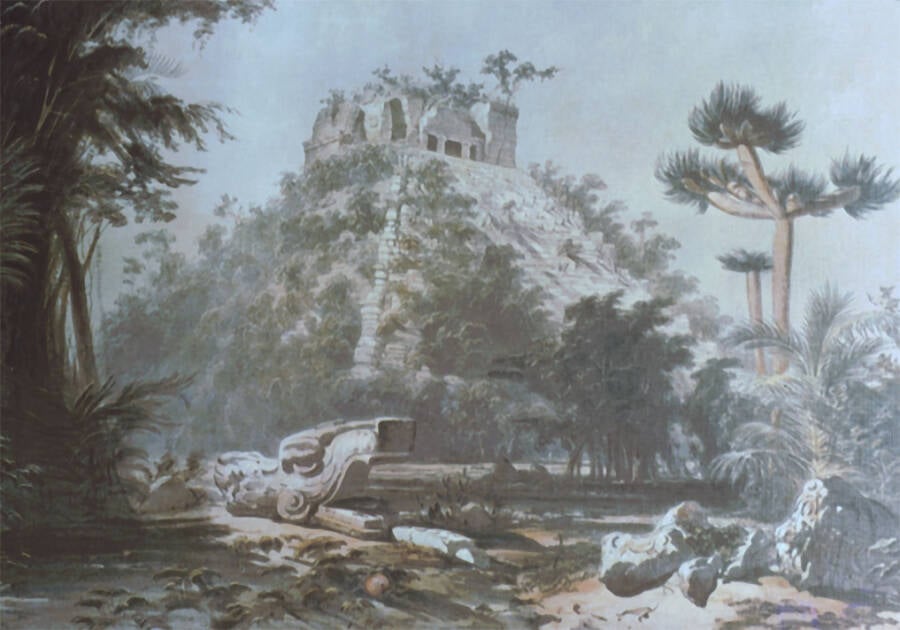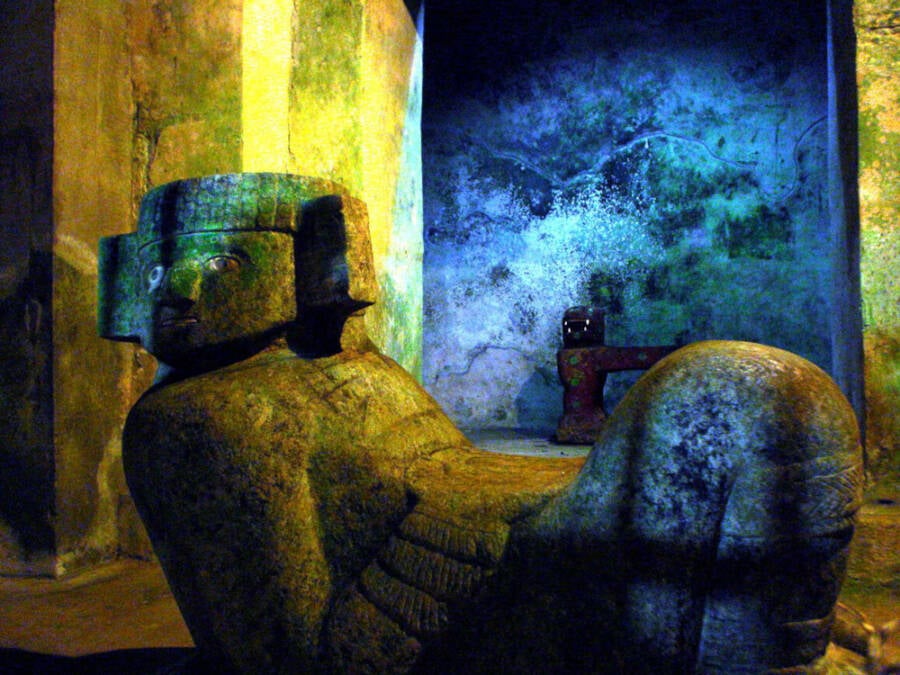Built between 1050 and 1300, El Castillo is a magnificent stone pyramid located at the center of the Maya city of Chichén Itzá that stands 79 feet tall and is 181 feet wide at its base.
When the first stones of the Temple of Kukulcan were laid, the Roman Empire was falling. By the time it was finished, the Muslim world was undergoing a golden age. Once abandoned, the elaborate Chichén Itzá pyramid, which the Spanish called “El Castillo” or “the castle,” was originally the sophisticated heart of one of the Maya civilization’s wealthiest and most impressive cities.

Wikimedia CommonsThe Temple of Kukulcan, or El Castillo, as it appears after its restoration in the early 20th century.
Long before Spanish conquerors arrived in what is now Mexico, the region was already one of the cradles of civilization. For centuries, successive peoples developed advanced astronomy, technology, cultures, and some of the grandest architecture seen on any continent.
One of the most impressive artifacts left behind by the Maya of Mexico’s Yucatán Peninsula is Chichén Itzá, a once-sprawling city built around the looming pyramid of El Castillo, or the Temple of Kukulcan. Read on to discover the fascinating story of this elaborate testament to the skill of Mexico’s ancient inhabitants.
What Is El Castillo?
El Castillo is one of the best-preserved examples of a Maya step pyramid, monumental structures built to honor specific deities, bury rulers, and form the centers of major cities. It’s one of over 20 buildings in the ruins of Chichén Itzá, a Maya city thought to have been founded around 400 C.E. But the 79-foot-tall pyramid at its center was among the earliest structures erected.
The earliest building work may have begun around 500 C.E., above a cenote, or a natural waterhole. For the ancient inhabitants of the Yucatán, cenotes were both their primary water source and sites of religious importance, seen as portals to Xibalba, “the place of fright,” or the Maya underworld.

Wikimedia Commons/SalhedineThe Sacred Cenote at Chichén Itzá is one of several in the area that held deep spiritual significance for the Maya.
To appease the rain god Chaac, according to the official website of Chichén Itzá, the Maya threw humans into cenotes as sacrifices, and as their civilization evolved, they built temples near them to emphasize their sacred purpose. El Castillo was dedicated to Kukulcan, the Maya feathered serpent god associated with rain, storms, and life.
The Rise And Fall Of The Ancient Temple
The design of the temple is a testament to the sophistication of the Maya as well as their deeply-held beliefs. On all four sides, there are staircases of 91 steps each. Adding up the total number of stairs plus the temple on top comes to 365, equal to the number of days in the Maya calendar. What’s more, the staircases divide the nine tiers of the pyramid to equal 18, the number of months in the calendar.
No one was ever meant to enter the pyramid. Instead, priests celebrated religious festivals and rituals and marked the changing seasons at the top.
Remarkably, the building appears to have been designed so that shadows create the illusion of Kukulcan himself slithering down the stairs on the spring and autumn equinoxes. Huge snake heads carved in stone around the base complete the illusion.

Wikimedia Commons/Frank KovalchekThe 10-foot-long snake heads at the base of Chichén Itzá’s pyramid are thought to represent the serpent god Kukulcan.
Chichén Itzá was at the height of its power from around 900 to 1050 C.E., when it was the dominant city in the northern and central Yucatán. Around 1100, the center of the Maya civilization shifted to Mayapan in the south for reasons that are still unclear but could include drought, warfare, and political opposition.
Whatever caused the decline of Chichén Itzá, Maya elites had long since abandoned the city by the time Spanish conquistadors led by Francisco de Montejo arrived in the Yucatan in 1527. However, the area was still heavily populated, leading Montejo to adopt the goal of reaching Chichén Itzá and establishing a capital there for Spanish rule.
Montejo’s son, also called Francisco, finally achieved his father’s ambition around 1531 when he founded the town of Ciudad Real among the ruins. These early conquerors named the ruined temple “El Castillo” or “the castle.”
Rediscovering The Chichén Itzá Pyramid
Resisting Maya forced the younger Montejo to abandon the city in 1534, and it would take the Spanish another 25 years to conquer northern Yucatán. But by the end of the 16th century, the region was firmly under colonial control.
For 300 years afterward, per the Simon Fraser University Museum of Archaeology and Ethnology, the ruins of Chichén Itzá served as a cattle ranch, largely forgotten and protected from prying eyes. But in 1841, the American diplomat and explorer John Lloyd Stephens traveled to the region with English artist Frederick Catherwood, visiting dozens of Maya ruins.

Public DomainThe Temple of Kukulcan, as depicted by Frederick Catherwood, captivated readers across the world.
Stephens and Catherwood weren’t the first to explore Chichén Itzá. But Stephens’ books Incidents of Travel in Central America, Chiapas, and Yucatán and Incidents of Travel in Yucatán did attract new attention to the grand monuments he found there, sparking a renewed interest in the Maya civilization.
“The Castillo,” wrote Stephens, was “from every point of view the grandest and most conspicuous object that towers above the plain.” Catherwood used a device called a camera lucida to precisely illustrate the city’s elaborate carvings and architectural features. Both died in the 1850s, but their detailed accounts and rich depictions would kickstart the study of the Maya civilization.
El Castillo’s Secrets Revealed
Between Stephens’ and Catherwood’s visit and the end of the 19th century, a new discipline arose that would unlock further secrets of El Castillo’s past: archaeology. In 1923, Sylvanus Morley, with funding from the Carnegie Institute, began the first full-scale excavation of the Chichén Itzá site. The Mexican government also began restoring the Chichén Itzá pyramid and the nearby ball court, where Itzans once played the infamous Mesoamerican ball game pelota.

Wikimedia CommonsArchaeologists believe this chacmool statue and other objects were left inside the temple when the original structures were built over.
Then, in 1935, archaeologists made an astonishing discovery. Researchers found a room, “the hall of offerings,” deep inside the structure containing a chacmool, or a sacred statue used in human sacrifice rituals. The following year, they located a second room, the “chamber of sacrifices,” which contained human bones and a precious red jaguar statue.
The researchers realized that there must have been an earlier temple on the site, which later Itzans had built over. Archaeologists theorized that the older pyramid may have been constructed between 800 and 1000 C.E., making the temple hundreds of years older than it was first thought to be.
The Temple Of Kukulcan In The Present Day
The Carnegie Institute’s funding went to research and restoration of the site as a tourist attraction by the Mexican government. Restorers used Catherwood’s illustrations as well as knowledge of other Maya ruins to imagine the site as it might have originally looked.
The reimagined site was an instant hit with tourists. Charles Lindbergh took aerial photos of the city, and until 2006, visitors could climb the stairs to the top of El Castillo to catch a view of the area as it may have looked to priests centuries ago.

National Air and Space MuseumCharles Lindbergh’s aerial photographs of Chichén Itzá were a groundbreaking achievement for archaeology.
But the city hasn’t given up all its secrets yet. In 2015, researchers using non-invasive imaging technology found what appeared to be a natural cavity beneath the pyramid — a cenote. It’s believed that this cenote may connect to others in the area. Underwater archaeologist Guillermo de Anda thinks the Maya may have believed the subterranean cave was a link to Xibalba, the underworld.
“The Maya conceived of the cosmos as having three basic layers: heavens, earth and underworld,” de Anda told CNN in 2018. “The underworld was very important — it was considered the origin of life, and if [the Maya] didn’t keep a good balance between this layer of the universe and their own it could mean drought, famine or sickness.”
Then, in 2017, another team using similar techniques found something even more fascinating: a third pyramid inside the other two. Archaeologists believe the Maya built this smaller pyramid between 500 and 800 C.E., placing it within the Classic Period when the Maya civilization first flourished.
Three pyramids, all built over a cenote and aligned to display the famous snake shadow, suggest that in its heyday, the Temple of Kukulcan and Chichén Itzá were immensely important to the ancient Maya. Could this site have been where they believed the feathered serpent god descended to Earth before continuing his journey to the underworld?
For now, only time and continued research will tell. Until then, about 2 million people visit Chichén Itzá every year to view El Castillo and explore this once-mighty Maya city.
After reading about the history of El Castillo, learn how the pyramids of ancient Egypt were built. Then, read about Gunung Padang, the Indonesian megalith that may be the oldest pyramid in the world.





